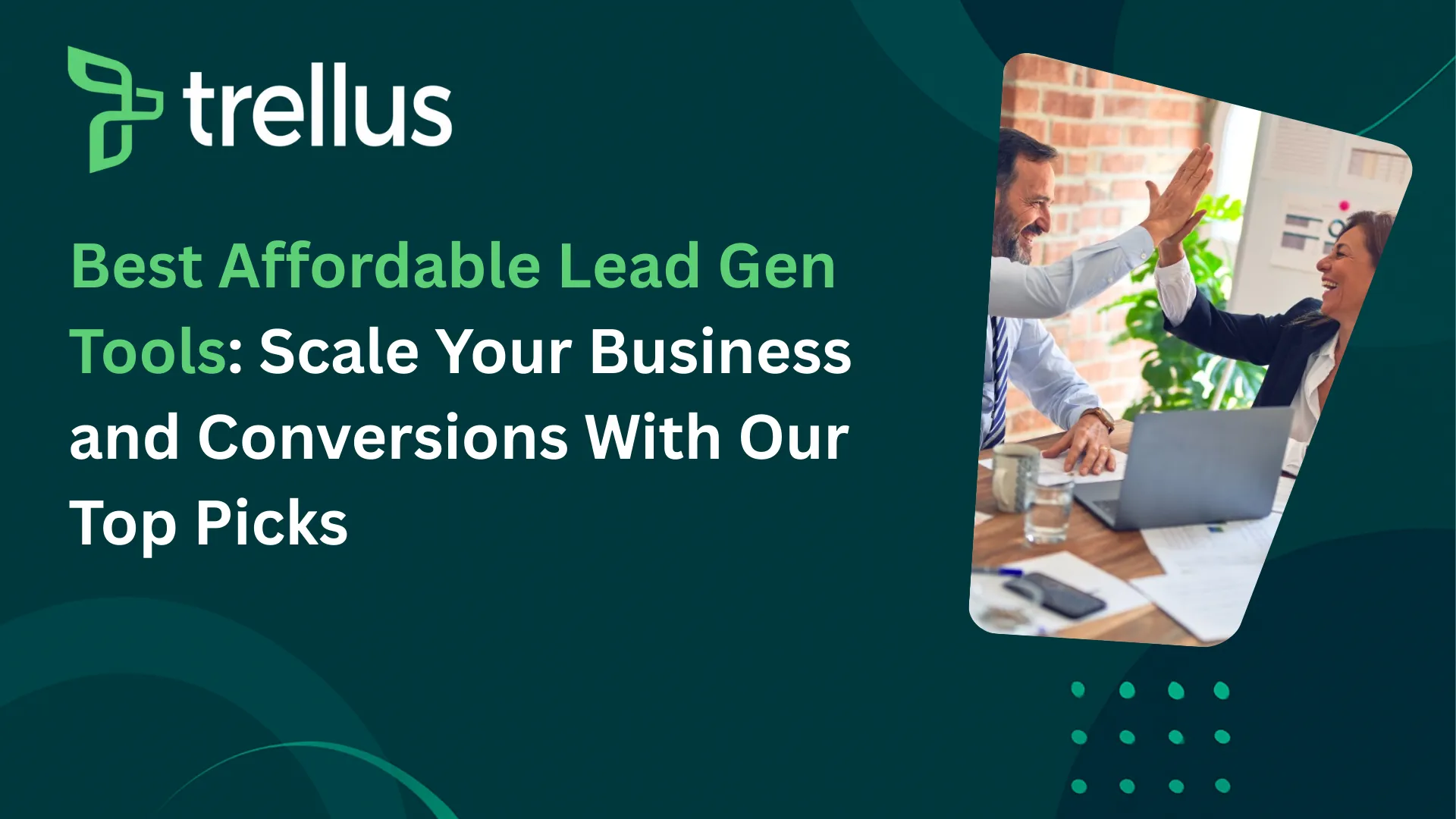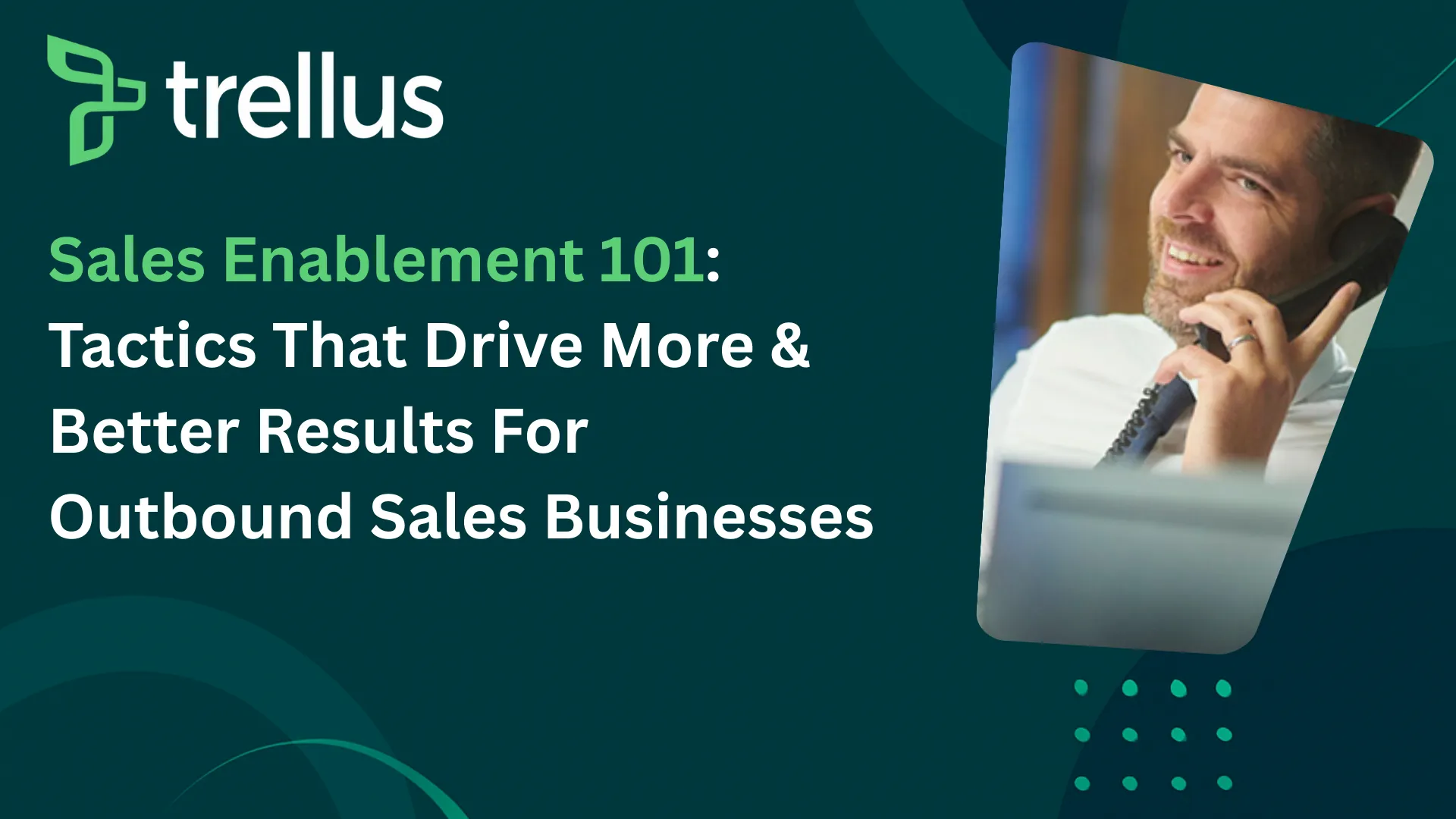
Our Top Picks


Strong sales training programs can turn good sellers into great ones. Over the course of the last few months, we have touched base on this topic at length.
If there’s one key takeaway that we’d recommend, it’s the manager's knack for pushing their teams to constantly learn new things. Sales enablement and conversion tactics are constantly evolving, and staying stagnant isn’t only counterproductive but also tends to dissuade SDRs from hitting those conversion targets.
But in today’s competitive landscape, training alone isn’t enough.
The top-performing revenue teams aren’t just handing out a product manual and calling it onboarding — they’re building a sales enablement strategy that runs deep into every part of the sales process.
As Marcela Piñeros, Global Head of Sales Enablement at Stripe, has noted, organizations with sales enablement see tangible benefits — including a 31% improvement in supporting sales messaging changes and a 15% improvement in performance among low-performing reps.
Those numbers are the result of constant fine-tuning, not set-it-and-forget-it planning.
When “done right”, any sales enablement plan is more than capable of helping to direct teams in a very strategic manner.
The important question is: how to get there, which tools to use along the way, and what to say when the road takes a turn.
This isn’t only about making life easier for your reps — it’s about putting more qualified revenue through the pipeline, improving engagement with buyers, and helping more sellers hit or exceed quota.
Let’s see what we have in store for you. Read on…
What Does a Sales Enablement Strategy Mean in Basic Terms?
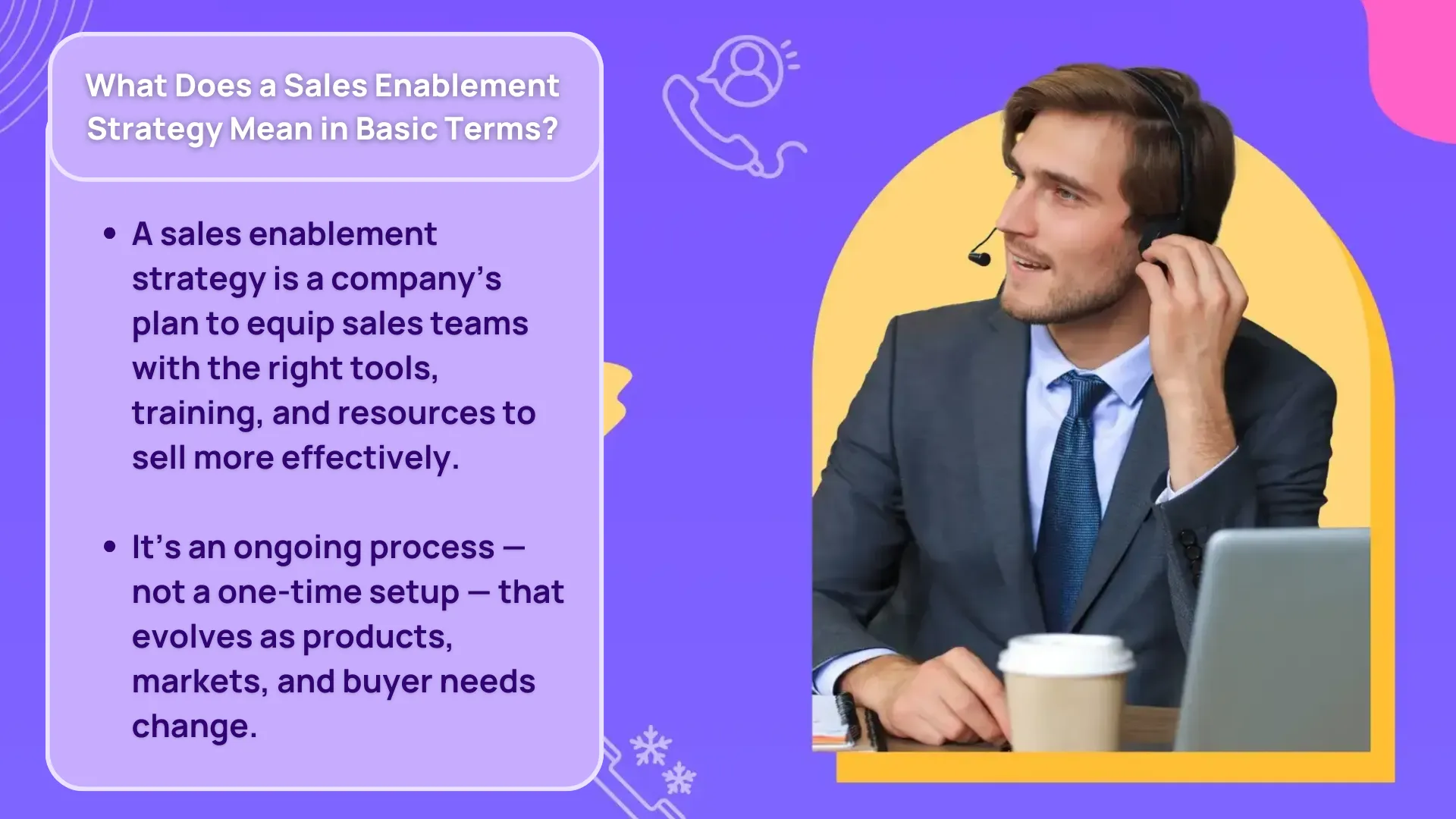
A sales enablement strategy is your organization’s plan for giving sales teams the tools, knowledge, and resources they need to sell effectively in the modern B2B climate.
That could possibly include:
- Clear and up-to-date sales content management
- Well-designed sales training programs
- Resources aligned to the buyer journey
- CRM integration for better visibility
- Coaching workflows and playbooks to handle real-world selling challenges
This isn’t a one-and-done project.
As we mentioned earlier, it starts the moment a rep is hired and continues through every stage of their tenure — adjusting as products evolve, markets shift, and buyer expectations change.
Why a Sales Enablement Strategy Is No Longer Optional
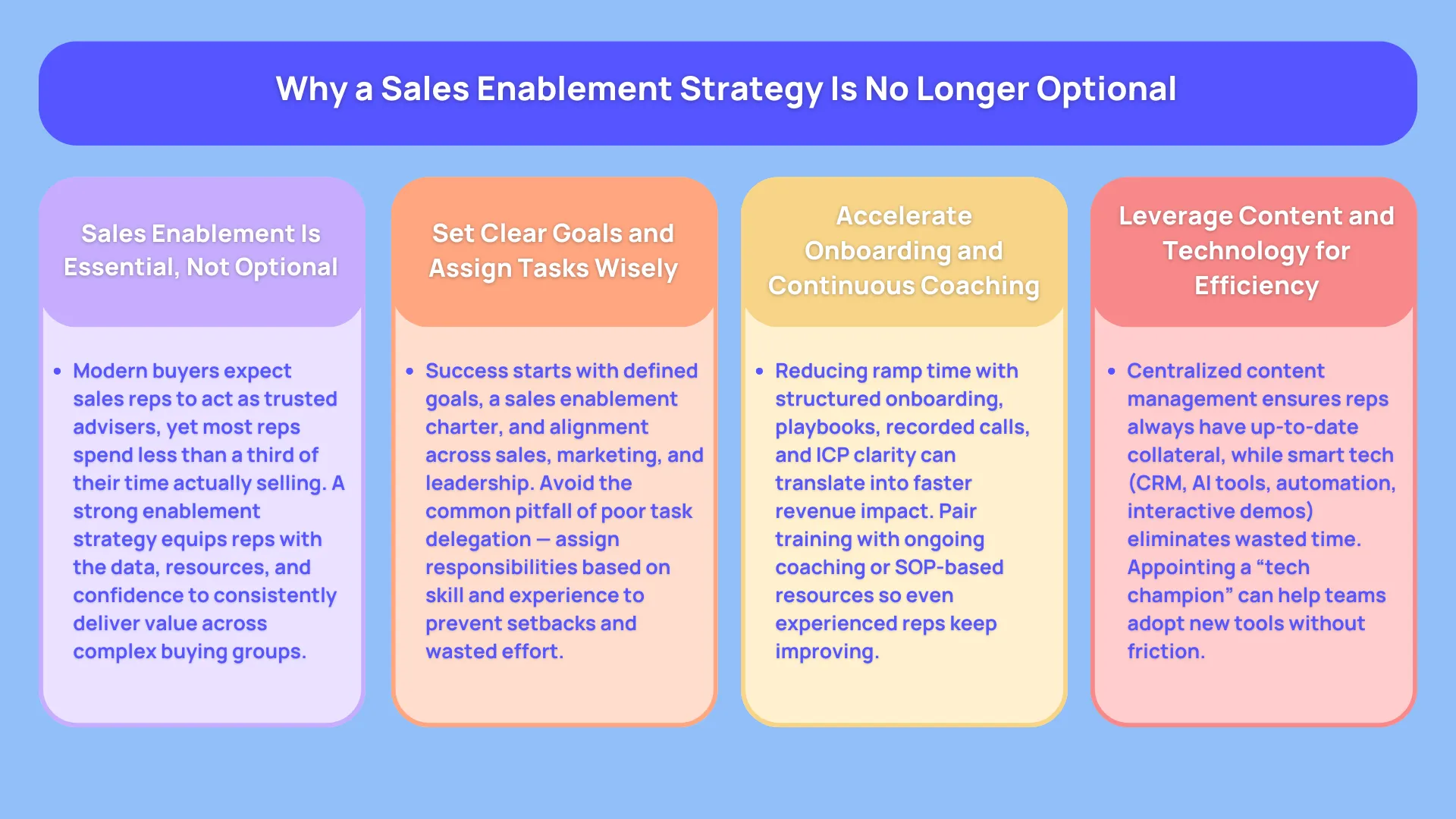
A well-built enablement plan isn’t just a “nice extra” — it’s now a foundational piece of any high-performing sales organization.
Depending on your business’s operational variables, your SDRs and people held accountable for bringing in outbound sales conversions could get by with one of the following aspects of a well crafted sales enablement strategy:
- Help new hires get up to speed faster and reduce ramp time
- Align sales messaging to meet buyer journey alignment expectations
- Streamline sales processes so reps spend more time selling and less time hunting for information
- Boost revenue by enabling reps to add value at every interaction
- Improve retention by giving sellers a clear path to success
Buyers today expect more than just a product pitch. In fact, from a statistical point of view,research shows that 87% of business buyers expect sales reps to act as trusted advisers, providing strategic insights and helping them make sense of their options.
Yet, the average rep spends less than a third of their time actively selling — and deals are involving more stakeholders than ever before. According to Gartner, the typical enterprise B2B buying group now includes decision-makers from at least five different business functions.
Without a plan to address this complexity, reps are forced to “wing it,” which makes it hard to consistently deliver value to every stakeholder.
In that sense, we'd say that any strong sales enablement plan ensures they have the confidence, data, and resources to do just that.
1. Create Clear Short Term Goals & Designate Targets Accordingly
Every strategy starts with clarity. Before you roll out sales enablement initiatives, you need to know exactly what you want to achieve and how you’ll measure it.
Why it matters: Without defined goals, you’ll end up with scattered activities that look busy but don’t move the needle. Your sales enablement goals should directly address the most pressing challenges your sales team is facing — whether that’s increasing win rates, shortening deal cycles, or improving the conversion rate from demo to close.
When defining your goals, don’t forget to:
- Document the mission and vision for your enablement function
- Identify the teams involved and the resources they’ll need
- Align with the sales and marketing alignment strategy so messaging is consistent
- Get buy-in from leadership and related departments such as product management and marketing
Once those goals are documented, go a step further and create a sales enablement charter. This is your blueprint for what your enablement team will deliver, who it will serve, and how you’ll measure success.
But in order for that to happen, there’s the task delegation part. Many times, managers do not assign tasks to people according to their skill level.
Although the strategy is A level, the task assignment often doesn’t regard a sales person’s previous skill history. In a high hustle work environment, this is something that “normally” happens and SDRs are expected to pace up by consulting their peers. However, there’s no guarantee that while doing so, these individuals will perform well, or just hit different setbacks without prior warning.
So, don’t take the risk and ensure that everyone gets assignments accordingly.
2. Create a World-Class Onboarding Program with Ongoing Coaching
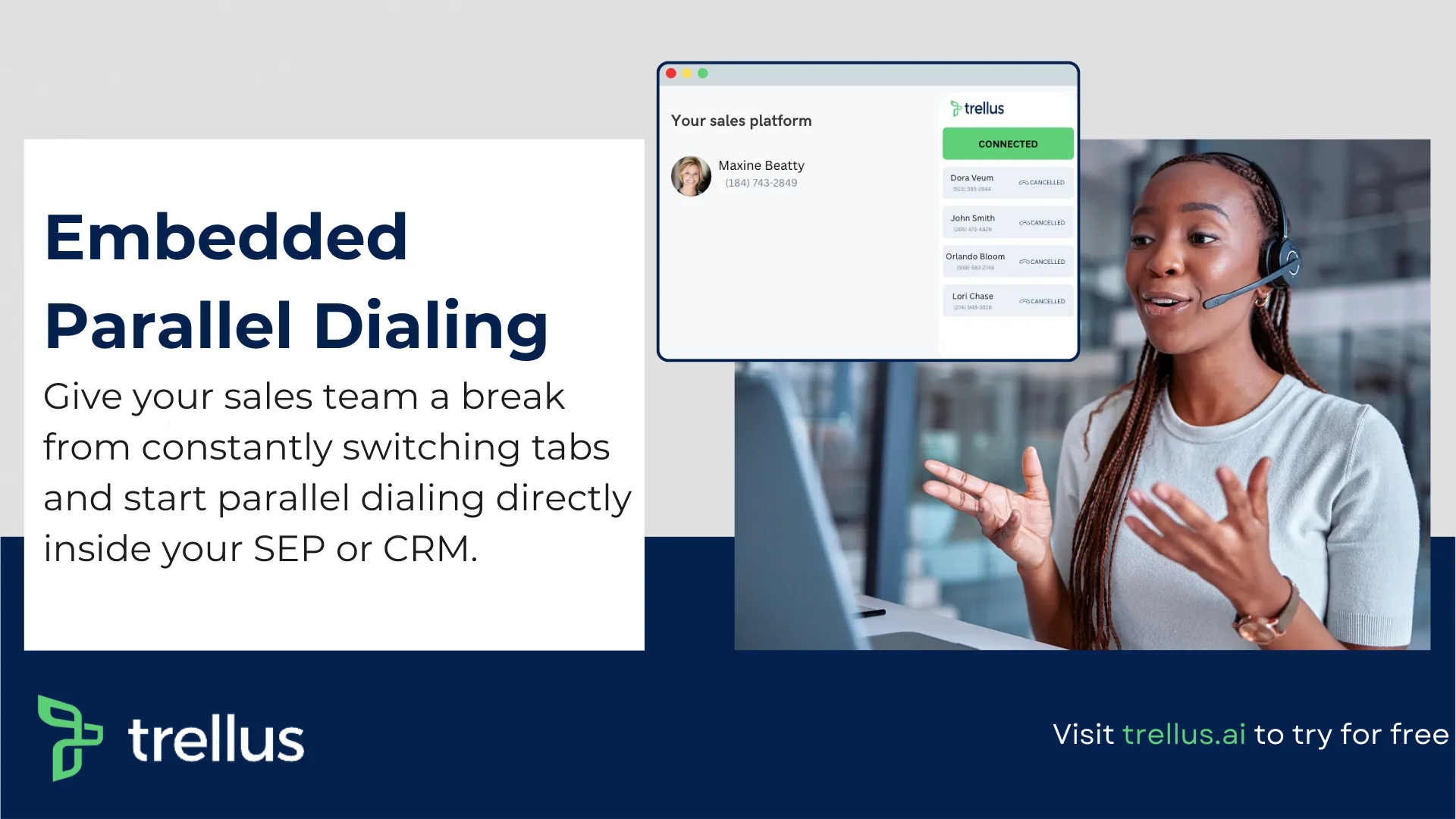
One of the fastest ways to drive revenue is by reducing new hire ramp time.
Your onboarding process should be a mix of sales training programs, real-world practice, and clear resources for every stage of the sales funnel.
Why it matters: The difference between a seven-month ramp and a five-month ramp could mean over $80,000 in additional revenue per rep. The sooner they close their first deal, the sooner they contribute meaningfully to your targets.
Key parts of effective onboarding and coaching workflows include:
- A clear ideal customer profile (ICP) so reps know exactly who to target (and who to avoid)
- Well-defined buyer personas outlining goals, pain points, and the value your solution provides
- Sales playbooks and scripts for calls, demos, and emails — updated regularly to reflect product changes
- A library of recorded customer calls that showcase best practices
- Stage-specific collateral so reps can deliver the right content at the right time
Pair onboarding with continuous coaching. Even your top performers benefit from regular feedback, call reviews, and peer learning opportunities.
If that’s not possible due to time and scheduling conflicts, then create SOPs and videos that teams can go through. Make sure that these processes are documented and a sitewide link is shared with everyone during the onboarding meeting.
3. Prioritize Sales Content Management
If your reps have to search through 15 different folders just to find a case study, your enablement strategy is broken.
For instance, a robust sales content management system should act as a single source of truth for all customer-facing materials.
A good setup ensures that:
- Reps always have the most current version of pitch decks, case studies, one-pagers, and proposals
- Collateral is tagged to specific stages of the buyer journey for easy access
- Marketing and sales work in sync, so messaging is consistent across touchpoints
This doesn’t just make life easier for sellers — it improves the buyer’s experience. When a prospect asks for information, they get it quickly, accurately, and in a format that makes sense for their decision-making process.
4. Use Technology to Automate and Support Sales Enablement
Modern sales enablement techniques often involve a smart tech stack. This doesn’t mean buying every flashy tool on the market — it means picking the right solutions that support your process.
Examples include:
- CRM integration for a complete view of the buyer’s history and engagement
- Lead nurturing tools that keep prospects engaged between touchpoints
- AI-assisted conversation intelligence to identify talk tracks that drive conversions
- Interactive product demos that shorten the decision-making cycle
Automation frees reps from repetitive tasks so they can focus on high-value conversations.
A potential issue that can occur during this process is the team’s adaptability curve. Some members are slow learners, and they require a bit of handholding during different onboarding processes.
While we did talk about creating SOPs and tutorial videos to straighten out any kinks, it’s also strongly recommended to appoint a technology champion for each team to help members out with any possible issues that they might have.
5. Align Sales Enablement with Buyer Journey Stages
Your enablement materials should meet buyers where they are — whether they’re just learning about the problem, comparing solutions, or ready to make a decision. This is the essence of buyer journey alignment.
For each stage, identify:
- The buyer’s main questions and concerns
- The type of content or conversation that addresses those concerns
- The role of the sales rep at that stage (educator, problem-solver, negotiator, etc.)
This alignment ensures prospects always feel understood and supported — not sold to.
6. Support Strategic Sales Enablement Initiatives
When your company launches a new go-to-market campaign, enters a new vertical, or shifts its product positioning, your sales enablement plan needs to move in lockstep.
Reps should receive:
- Clear training on why the initiative matters
- New or updated sales playbooks with relevant talk tracks
- Competitive intel and objection handling resources
- Fresh collateral to match the updated messaging
If your sales team doesn’t fully understand or believe in the initiative, it will stall before it ever reaches the market.
7. Build a Sales Enablement Team That Drives Performance
Knowing how to build a sales enablement team is just as important as knowing what they’ll deliver. The team might start small — one enablement manager or even a sales leader wearing two hats — but it should grow as your organization scales.
Core functions often include:
- Content creation and sales content management
- Training and onboarding program design
- Sales performance analytics and reporting
- Coaching and peer learning facilitation
- CRM and tech stack administration
A strong team ensures your strategy isn’t just a one-off project but a sustained competitive advantage.
8. Use Sales Performance Analytics to Refine Strategy
Sales performance analytics give you the hard data you need to make informed adjustments. Track both activity metrics (calls made, emails sent, demos booked) and outcome metrics (win rate, deal cycle length, average deal size).
Some high-value metrics to monitor:
- Ramp time to first deal, segmented by hire cohort
- Deal cycle speed compared to benchmarks
- Talk track adoption and its correlation to close rates
- Peer-to-peer learning engagement (who’s listening to calls, giving feedback, and applying new techniques)
The goal isn’t just to collect data — it’s to act on it. If you see a consistent drop-off in the negotiation stage, that’s a clear signal to introduce targeted training or update your playbooks.
9. Maintain Sales and Marketing Alignment
True sales and marketing alignment means both teams share the same understanding of the buyer, the market, and the messaging. It’s not just about marketing handing over leads — it’s about a constant feedback loop.
Enablement plays a key role by:
- Coordinating regular meetings between sales and marketing leaders
- Sharing real buyer feedback to influence campaign direction
- Ensuring sales have the right marketing assets and know when to use them
- Helping marketing understand which content is driving deals forward
When alignment is strong, lead quality improves, conversion rates rise, and the buyer gets a consistent, confident experience from first click to closed deal.
10. Keep the Strategy Evolving Through Continuous Feedback and Aggressive Implementation
A sales enablement strategy example that works today might be outdated in six months. Markets shift, products evolve, competitors make moves. That’s why enablement has to be an ongoing, adaptive process.
Use both quantitative metrics and qualitative input to guide adjustments:
- Sales performance analytics for measurable outcomes
- Rep feedback sessions to surface pain points
- Buyer feedback to ensure your approach stays relevant
- Regular reviews of sales content to keep it fresh
Wrapping It Up
Building a sales enablement strategy that drives revenue in 2025 isn’t about flashy tools or endless training modules.
It’s about creating a connected system where goals are clear, resources are accessible, technology supports the process, and teams stay aligned.
When your reps have the right mix of training, sales playbooks, CRM insights, buyer journey alignment, and ongoing coaching, they’re not just selling — they’re leading buyers confidently through decisions. And that’s what keeps your pipeline healthy, your win rates high, and your top talent sticking around for the long term.


.jpeg)


